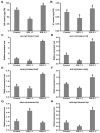Effects of Photoperiod and Light Quality on Germination and Growth of Camellia sinensis 'HuangKui'
- PMID: 38999624
- PMCID: PMC11244327
- DOI: 10.3390/plants13131782
Effects of Photoperiod and Light Quality on Germination and Growth of Camellia sinensis 'HuangKui'
Abstract
Light, as a critical environmental factor, plays a pivotal role in photosynthesis, ultimately influencing the timing of bud flush in tea plants. However, the synergistic effects of different photoperiods and light qualities on the timing of bud flush in the albino tea cultivar 'HuangKui' (later germination variety) remain unknown. Thus, the objective of this study was to investigate the effects of different photoperiods (12L/12D, 14L/10D, 16L/8D, and 18L/6D, where L = the number of daylight hours and D = the number of hours of darkness) and ratios of red (R) to blue (B) light (R/B 1:1, R/B 1:2, R/B 1:3, and R/B 2:1) on the germination and growth of the albino tea variety 'HuangKui'. In our study, we examined how different photoperiods and red light and blue light affected tea germination and growth by investigating the timing of bud flush, photosynthesis, chlorophyll content, and growth indicators. First, our study showed that 'HuangKui' germinated 4 days, 2 days, and 1 day earlier under the 16L/8D photoperiod at the one bud and one leaf period compared with plants cultivated under the 12L/12D, 14L/10D, and 18L/6D photoperiods under light simulating the solar spectrum. Also, the growth of 'HuangKui' was maximumly promoted under the 16L/8D photoperiod treatment. Additionally, the earliest germination of 'HuangKui' was observed for the 16L/8D photoperiod under the R/B 2:1 (red/blue) treatment compared with the other treatments. Moreover, the greatest plant height, length of the new shoots, and new leaf areas were detected in the albino tea variety 'HuangKui' under R/B 2:1. Moreover, the contents of auxin (indole acetic acid, IAA) and trans-zeatin (tZ) under R/B 2:1 were significantly higher than those under the R/B 1:1 and control treatments with the 16L/8D photoperiod. Additionally, the auxin-related expression levels of CsIAA13, CsGH3.1, CsAUX1, and CsARF2 under the R/B 2:1 treatment were significantly higher than those in the control. The expression of CsARR-B, a positive regulator of cytokinin-related genes, was significantly higher under the R/B 2:1 treatment than under the control treatment, while the opposite result was found for the expression of the negative regulator CsARR-A. Therefore, the R/B 2:1 treatment with the 16L/8D photoperiod was an appropriate means of timing the bud flush for the albino tea variety 'HuangKui', which may be related to IAA or tZ signal transduction. In conclusion, our research offers a novel lighting strategy that promotes the germination and growth of albino tea cultivars.
Keywords: germination; light quality; photoperiod; tea plants.
Conflict of interest statement
The authors declare no conflict of interest.
Figures









References
-
- Chang N., Zhou Z., Li Y., Zhang X. Exogenously applied Spd and Spm enhance drought tolerance in tea plants by increasing fatty acid desaturation and plasma membrane H+-ATPase activity. Plant Physiol. Biochem. 2022;170:225–233. - PubMed
-
- Hao G., Zheng Z., Ma H., Ye Y., Guo M., Cheng H., Rua L. New albino tea variety-Zhongbai 4. China Tea. 2019;41:11–13.
Grants and funding
LinkOut - more resources
Full Text Sources

